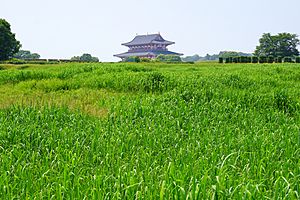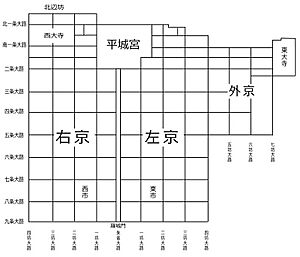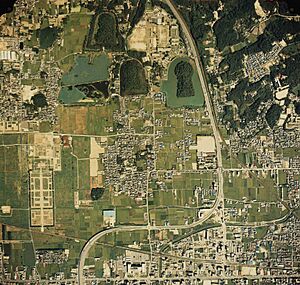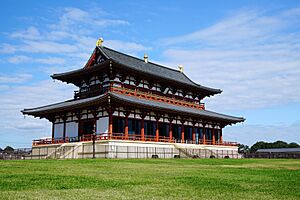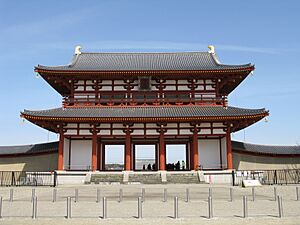Heijō-kyō facts for kids

Heijō-kyō (平城京) (also called Heizei-kyō or Nara no miyako) was the main Capital of Japan for much of the Nara period. This important city served as the capital from 710 to 740, and again from 745 to 784. The Heijō Palace, where the emperor lived, is now a UNESCO World Heritage site. It is part of the Historic Monuments of Ancient Nara.
In 708, Empress Genmei decided to move the capital from Fujiwara-kyō to Heijō-kyō. The move was finished in 710. Heijō-kyō was designed like Chang'an, the capital city of Tang-dynasty China. However, Heijō-kyō did not have walls around it.
Heijō-kyō became a busy and important city. Merchants and traders from China, Korea, and India came to the city. They brought different cultures and goods through the famous Silk Road. Because of this, Heijō-kyō grew into Japan's first international capital. It was also a major political center. At its busiest, between 50,000 and 100,000 people lived there. The city was shaped like a rectangle and covered more than 25 square kilometers.
Ancient Architecture of Heijō-kyō
The area around Heijō-kyō is home to many old Buddhist temples. Some of these temples are also listed as UNESCO World Heritage sites, just like the Heijō Palace. These buildings show the amazing architecture of the Nara period.
Here are some of the important historical buildings and temples in the area:
- Daian-ji (大安寺)
- Daikokuden (大極殿, a reconstructed building)
- Gangō-ji (元興寺)
- Kōfuku-ji (興福寺)
- Saidai-ji (西大寺)
- Suzakumon (朱雀門, a reconstructed gate)
- Tōdai-ji (東大寺)
- Yakushi-ji (薬師寺)
1,300th Anniversary Celebrations
The year 2010 was a special year for Heijō-kyō. It marked 1,300 years since the city was first established as Japan's capital. To celebrate this big anniversary, many events were held in and around Nara Prefecture. These celebrations took place from April 24 to November 7, 2010.
The events included:
- Special exhibits of national treasures and other cultural items.
- Walking tours to explore famous places in Nara.
- Traditional events held in different parts of Nara.
The main celebration site was the Heijō-kyō Capital Area. This area had several special zones for visitors to enjoy:
- Entrance Plaza: This area had a tour center and a hall for companies.
- Heijō History Museum: Here, you could see a full-size copy of a Japanese ship. These ships were used for sending envoys to Tang China.
- Suzaku Gate Plaza: This plaza featured the reconstructed Suzaku Gate.
- Exchange Plaza: This area had a stage for performances and an exchange hall.
- Heijō Palace Site Museum: A museum dedicated to the palace site.
- Front Courtyard of the Former Imperial Audience Hall: An open area in front of the main hall.
- South Gate Plaza: Where you could rent traditional Tempyo period costumes.
- Heijō-kyō Hands-on Learning Plaza: A center for interactive learning about the city.
- Excavation Site Exhibition Hall: Showcasing discoveries from archaeological digs.
- Eastern Palace Garden Plaza: Featuring the beautiful Eastern Palace Garden.
Other events were held in different areas of Nara, including:
- Ikaruga and Shigi-san Areas (like Ikaruga)
- Asuka and Fujiwara Areas (like Asuka)
- Katsuragi Area
- Yoshino Area (like Mount Yoshino)
- Yamato Kogen Plains and Uda Area
See also
 In Spanish: Heijō-kyō para niños
In Spanish: Heijō-kyō para niños


